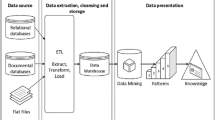Abstract
Over the years many studies have been done to investigate the determinants of student performance in courses of particular fields of study. However, this is not true of Introduction to Business and Economics Statistics. Our objective is to identify the correlates of student performance both overall, and on individual exams, in an Introduction to Business and Economics Statistics course. A wide variety of variables are found to significantly influence the performance of students, including their grades on previous exams and examination design. Our results indicate that it is important to isolate performance on individual exams.
Similar content being viewed by others
References
Allison, D.E.; D.C. Thomas. “Item-Difficulty Sequence in Achievement Examinations: Examinees Preference and Test Taking Strategies.”Psychological Reports. 59 (2. Part 2), 1986: 867–870.
Bach, G.L.; P. Saunders. “Economic Education: Aspirations and Achievements.”American Economic Review, 55(3), 1965: 329–356.
Becker, W.E. “Building Theoretical Models.” InEconometric Modeling in Economic Education Research. ed. W.E. Becker and W.B. Walstad, Kluwer, Boston. 1987a: 19–26.
Becker, W.E. “Measuring Intervention, Interaction, and Distribution Effects with Dummy Variables.” InEconometric Modeling in Economic Education Research. ed. W.E. Becker and W.B. Walstad, Kluwer, Boston, 1987b: 27–50.
Becker, W.E.. “Teaching Statistical Methods to Undergraduate Economics Students.”AEA Papers and Proceedings, 77 (2), 1987c: 18–23.
Bonello, F.J.; T.R. Swartz; W.I. Davisson. “Freshmen-Sophomore Learning Differentials: A Comment.”J. of Econ. Education, 15(3), 1984: 205–210.
Brasfield, D.W.; D.E. Harrison; J.P. McCoy. “The Impact of High School Economics on the College Principles of Economics Course,”J. of Econ. Education, 24(2), 1993: 99–111.
Bresnock, A.E.; P.E. Graves; N. White. “Multiple-Choice Testing: Question and Response Position,”J. of Econ. Education, 20(3), 1989: 239–45.
Caudill, S.B.; D.M. Gropper. “Test Structure. Human Capital, and Student Performance on Economics Exams,”J. of Econ. Education, 22(4), 1991: 303–6.
Durden, G.C.; L.V. Ellis “The Effects of Attendance on Student Learning in Principles of Economics.”AEA Papers and Proceedings, 85(2), 1995: 343–6.
Gohmann, S.F.; L.C. Spector. “Test Scrambling and Student Performance,”J. of Economic Education. 20(3), 1989: 235–8.
Hanke, J.E.; A.G. Reitsch.Fundamentals of Business Stastics. Charles and Merrill Pub., Columbus, Ohio. 1986.
Hanushek, E.A.. “Conceptual and Empirical Issues in the Estimation of Educational Production Functions.”Jour. of Human Resources, 14(3), 1979: 351–388.
Hanushek, E.A.Education and Race D.C. Health Lexington, Mass. 1972.
Heath, J.A. “An Econometric Model of the Role of Gender in Economic Education,”AEA Papers and Proceedings, 79(2), 1989: 226–230.
Karstensson, L.; R.K. Vedder. “A note on Attitude as a Factor in Learning Economics,”J. of Econ. Education, 5(1), 1974): 109–111.
Laband, D.N.; M.J. Piette. “Does Who Teaches Principles of Economics Matter?”AEA Papers and Proceedings, 85(2), 1995: 335–8.
Lawson, D.L.. “The Role of Attitude in Learning Economics: Race and Gender Differences”J. of Economics and Finance, 18(2), 1994: 139–152.
Leary, L.F.; N.J. Dorans. “Implications for Altering the Context in which test Items Appear: A Historical Perspective on an Immediate Concern,”Review of Educational Research, 55(3), 1985): 387–413.
Lumsden, K.G.; A. Scott. “The Economics Student Reexamined: Male-Female Differences in Comprehension,”J. of Econ. Education, 18(4), 1987: 365–375.
MacDowell, M.A.; P.R. Senn; J.C. Soper. “Does Sex Really Matter?,”J. of Economic Education, 9(1), 1977): 28–33.
MaxWell, Nan L.; Jane S. Lopus. “The Lake Wobegon Effect in Student Self-Reported Data,”AEA Papers and Proceedings. 84(2), 1994: 201–205.
Myatt, A.; C. Waddell. “An Approach to Testing the Effectiveness of the Teaching and Learning of Economics in High School,”J. of Econ. Education. 21(3), 1990: 355–63.
Reid, R.. “A Note on the Environment as a Factor Affecting Student Performance in Principles of Economics,”J. of Econ. Education, 14(4), 1983: 18–22.
Romer, D.. “Do Students Go to Class? Should They?,”Journal of Economic, Perspectives, 7(3), 1993: 167–174.
Siegfried, J.J.; R. Fels. “Research on Teaching College Economics: A Survey,”Journal of Economic Literature. XVII(3) 1979: 923–969.
Swan, C. “Simultaneous Equations Estimation.” InEconometric Modeling in Economic Education Research. ed. W.E. Becker and W.B. Walstad, Kluwer, Boston, 1987: 99–109.
Taub, A.J.; E.B. Bell. “A Bias in Scores on Multiple-Form Exams.”J. of Econ. Education., 7(1), 1975:58–9.
Walstad, W.B. “Applying Two-Stage Least Squares,” InEconometric Modeling in Economic Education Research, ed. W.E. Becker and W.B. Walstad. Kluwer. Boston, 1987:111–134.
Zellner, Arnold. “An Efficient Method of Estimating Seemingly Unrelated Regressions and Tests for Aggregation Bias.”Journal of the American Statistical Association, 57(298), 1962: 348–368.
Author information
Authors and Affiliations
Rights and permissions
About this article
Cite this article
Krieg, R.G., Uyar, B. Correlates of student performance in Business and Economics Statistics. J Econ Finance 21, 65–74 (1997). https://doi.org/10.1007/BF02929040
Issue Date:
DOI: https://doi.org/10.1007/BF02929040




